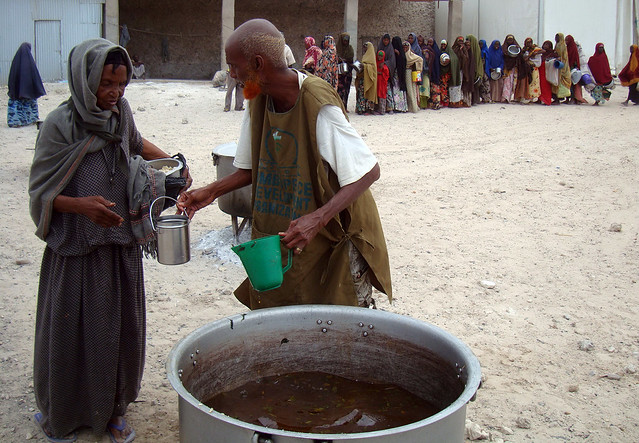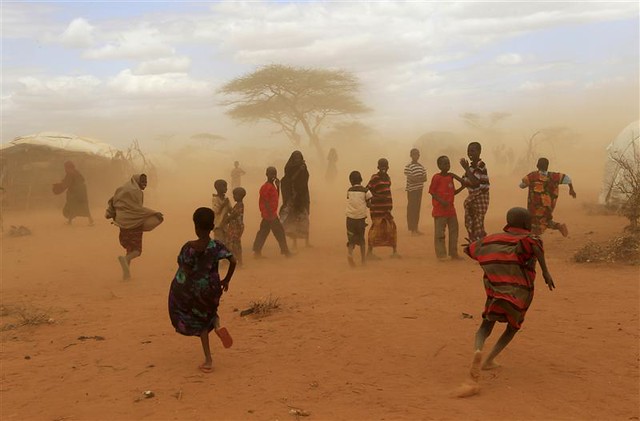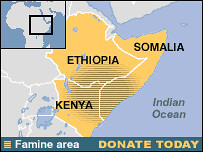
Situación de Sequía en Somalia. Somali women displaced by severe drought conditions queue to get food handouts at a centre operated by the government and local NGOs, south of Mogadishu July 7, 2011. REUTERS/Feisal Oma
East Africa Food Crisis: 48 hour Famine Fundraiser
Daily Kos joins a network of environmental websites, nonprofits, and social media mavens this weekend in a 48-hour fundraiser to benefit the 12 million people struggling for survival in East Africa.
The UN, after declaring famine in two districts in Somalia, last week announced the entire region of southern-Somalia is in danger of slipping into famine.
Also participating in this weekend of action are 350.org, Oxfam International, WiserEarth,tcktcktck, DeSmogBlog, MIT Climate CoLab, BPI Campus, Climate Change: The Next Generation, RedGreenAndBlue.org, Cool HIVE, and MedicMobile.
Awareness is key. Over the course of the weekend, experts in the field of humanitarian assistance will join environmental writers to outline the history of the region and detail how geopolitics, colonialism, ongoing civil wars, climate change and geographic vulnerabilities have combined to create the perfect storm now ravaging East Africa.
Throughout the 48-hour period, DailyKos bloggers will link directly to the content written by other participating organizations and sites.
Each participant in the 48-hour fundraiser will identify the recipient of its donation.

Schedule: Saturday-Sunday August 6-7 PST
6-8: Una Spencer: Introduction
8-10: A Siegel: Out of Sight, Out of Mind
10-12: rb137
12-2: FishOutofWater
2-4: wader:
4-6: Jeremy Bloom
8-10: Oke
Overnight: boatsie
Sunday, August 7
6-8: blue jersey mom: Inadequacy of US Humanitarian Aide
8-10: Daisy Carlson: Cool HIVE
10-12: 350.org
12-2 Ellinorianne
2-4: Patiot Daily
4-6: : JekyllnHyde
6-8: Jennifer Miller Smith
8-10: Jill Richardson
Overnight: Chacounne


Situación de Sequía en Somalia. Newly-arrived refugees run away from a cloud of dust at the Dagahaley refugee camp in Dadaab, near Kenya's border with Somalia, July 16, 2011. Britain's Secretary of State for International Development Andrew Mitchell on Saturday visited Dadaab refugee camps, where he met displaced families forced to leave their homes in Somalia in order to survive. REUTERS/Thomas Mukoya
ABC News David Muir is the first American network reporter to cover the famine in Somalia. These photos were taken in Mogadishu.
Ways to Participate

• Post the graphic on your site, Twitter, Google + or Facebook account to publicize your support.
• Participate in publicizing the event through social networking: Hashtag = #48forEastAfrica
• Get in touch with your media contacts
• Let us know in comments below how you can help.
HELP! Kos EcoJustice Team Africa Top 3 Choices for Donations to Horn of Africa Crisis
• Save the Children
• MEDECINS SANS FRONTIERES/Doctors Without Borders
• The World Food Programme: Fill the Cup: (THE WFP needs $200 million just to meet this year's needs in the Horn of Africa.)
ADDITIONAL IDEAS
• Care International
• UNICEF: Donate to Save Children in Horn of Africa Crisis
• FreeRice- donates 10 grains of rice to the WFP for each answer you answer correctly.
• The HungerSite - Click to give free food.
• WFT: 10 Ways You Can Help
Horn of Africa Drought Facts (combined sources)
• More than 12 million people are affected in Somalia, Kenya, Djibouti, Sudan and Uganda
• Nearly half of Somalia's population is facing a humanitarian crisis - almost 3.7 million people
• Over 2 million children under the age of five who are suffering from malnutrition; 480,000 are severely malnourished
• UN declares famine in two districts- Bakool and Lower Shabelle - in southern Somalia; anticipates spread of famine throughout the entire southern Somalia region.
• Women are disproportionally affected by the drought as they are the last to eat when food is limited.
• Aid response nearly $1 billion short of what is needed
• Immunizations have begun in Daab Refugee camp, where medical teams are in serious need of additional supplies.
• Over $1bn has been committed but a further $1bn is still required to save thousands of lives
What is a Famine
Most major aid agencies - the FAO, the WFP, the Famine Early Warning Systems Network, Save the Children UK, CARE International, the European Commission Joint Research Centre and Oxfam - only describe a crisis as a famine when the situation on the ground reaches level five on the Integrated Phase Classification (IPC) system. This means:
* at least 20% of the population has access to fewer than 2,100 kilocalories of food a day
* acute malnutrition in more than 30% of children
* two deaths per 10,000 people, or four child deaths per 10,000 children every day
Famine Scales
Magnitude scale:
Category A: Minor Famine: 0-999
Category B: Moderate famine Mortality Range:1,000-9,999
Category C: Major famine 10,000-99,999
Category D Great famine 100,000-999,999
Category E Catastrophic famine 1,000,000 and over
Resources
•BBC: What you Need to Know
• Q&A: BBC
• Al Jazeera Horn of Africa (english)
• How Bad is the Horn of Africa Drought: AlertNet Q&A:
• PBS Newshour: PhotoEssay: 7/11
• Guardian Interactive Horn of Africa Drought Map
• Why doesn't a drought go away when it rains?
• Oxfam: Food crisis in Wajir, Kenya
• Fighting Famine in Southern Africa: Steps out of the Crisis. The International Food Policy Research Institute (IFPRI) recently released a report outlining sustainable options for ending hunger and poverty, tailored to address famine in Africa.

Coverage @ KOS
This is the latest in a series of diaries covering the Horn Of Africa Crisis. Please visit previous entries at the Ecojustice Group.

Social Media
Twitter: #HornofAfrica, #drought, #famine
Facebook: Horn of Africa
MapSourcing
Regional Drought Response Plan: East Africa Droughts.


